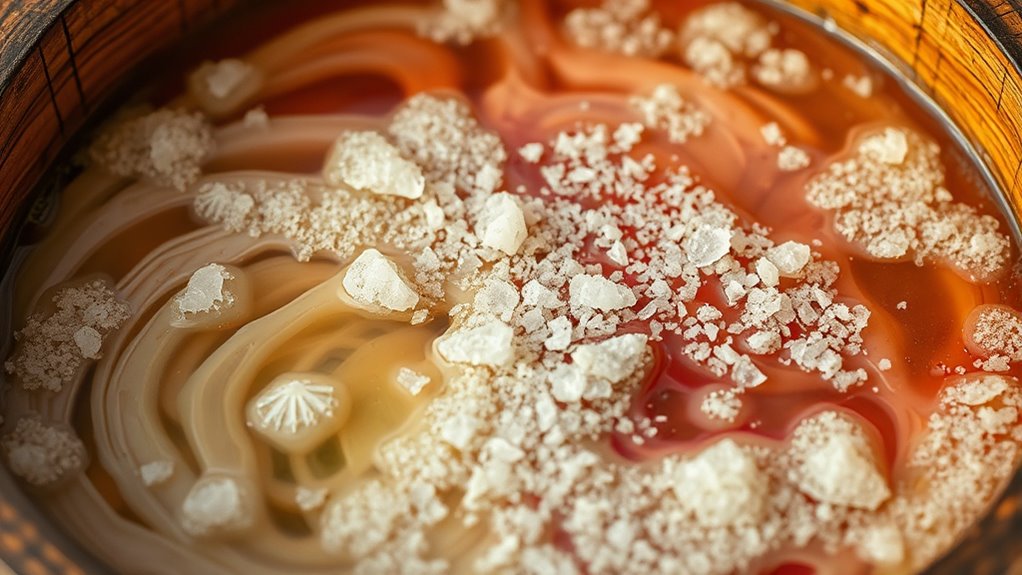Salt plays a vital role in fermentation by controlling microbial activity and creating a safe, stable environment. It inhibits unwanted bacteria and molds while promoting beneficial microbes like lactobacilli. Salt also draws out moisture, which helps develop flavor and preserves the food. By adjusting salt levels, you shape the microbial community and influence the fermentation result. If you want to understand how salt turns fermentation into a microbial playground, keep exploring the details.
Key Takeaways
- Salt creates an ideal environment for beneficial microbes by regulating moisture and inhibiting harmful bacteria.
- It influences microbial ecology, promoting the growth of desirable microorganisms like lactobacilli.
- Salt’s antimicrobial properties suppress molds and pathogens, ensuring fermentation safety.
- Proper salt levels shape the microbial community, enhancing flavor development and fermentation quality.
- Salt acts as a natural regulator, guiding microbial balance and promoting a healthy, diverse fermentation ecosystem.

Have you ever wondered why salt is a key ingredient in fermentation? It’s not just about flavor; salt plays a crucial role in creating the ideal environment for beneficial microbes to thrive. When you understand salt curing and brine composition, you’ll see how salt acts as a natural regulator, shaping the fermentation process and ensuring safety. Salt curing involves applying salt directly to food, which draws out moisture and inhibits unwanted bacteria. This process helps preserve foods like meats and vegetables while promoting the growth of desirable microorganisms. In fermentation, salt curing sets the stage by reducing surface moisture and creating a hostile environment for spoilage organisms, giving beneficial microbes a competitive edge. Additionally, understanding microbial ecology in fermentation helps explain how salt influences the balance of microbes.
Salt is essential in fermentation for safety, preservation, and promoting beneficial microbes.
Brine composition, on the other hand, refers to the saltwater solution you use to ferment foods like sauerkraut, kimchi, or pickles. The concentration of salt in the brine directly influences which microbes can flourish. Too much salt and the environment becomes too harsh for most bacteria, slowing down fermentation or halting it altogether. Too little and harmful bacteria might take hold, risking spoilage or unsafe products. Achieving the right balance is key, and that’s where understanding brine composition helps you fine-tune the process. The ideal brine typically contains around 2-3% salt by weight, enough to inhibit pathogens but still allow beneficial fermentation bacteria like lactobacilli to dominate. The antimicrobial properties of salt are essential here, as they selectively suppress undesirable bacteria and molds, giving beneficial microbes room to multiply.
Salt’s antimicrobial properties are essential here. It selectively suppresses undesirable bacteria and molds, giving beneficial microbes room to multiply. As fermentation progresses, these microbes produce lactic acid, which further lowers the pH and preserves the food. This natural acidity acts as a barrier against spoilage and pathogens, ensuring the safety of your preserved foods. When you adjust the salt levels in your brine, you’re not just controlling flavor — you’re actively shaping the microbial community. Proper salt concentration encourages a healthy fermentation environment, enhancing both safety and flavor development. Understanding microbial ecology principles guide fermentation practices to optimize safety and flavor.
Frequently Asked Questions
How Does Salt Influence Fermentation Speed?
Salt slows down fermentation by increasing osmotic pressure, which limits water availability for microbes. This reduction in water activity decreases microbial activity, leading to a slower fermentation process. You’ll notice that with higher salt levels, fermentation takes longer because microbes struggle to function efficiently. Controlling salt amounts lets you regulate fermentation speed, ensuring it proceeds at a steady, safe rate while maintaining flavor and preventing spoilage.
Can Salt Levels Vary for Different Fermented Foods?
Imagine you’re tuning a musical instrument; salinity adjustments are like adjusting tension for the perfect note. Yes, salt levels vary for different fermented foods, as salt variability influences texture, flavor, and safety. You tailor salt concentrations based on the type of food, climate, and desired fermentation pace. This guarantees each fermentation process hits the right note, balancing microbial activity and preservation through precise salt adjustments.
What Are the Health Impacts of Consuming Fermented Foods With Salt?
When you consume fermented foods with salt, your sodium intake increases, which can impact your cardiovascular health if you eat too much. Moderate consumption can benefit your gut by providing probiotics, but excessive salt may raise your blood pressure and strain your heart. It’s important to balance fermented foods with other low-sodium options to protect your cardiovascular health and maintain overall well-being.
Is There a Difference Between Sea Salt and Table Salt in Fermentation?
Did you know that sea salt contains up to 80 minerals, while table salt is almost pure sodium chloride? In fermentation, this difference matters; sea salt’s mineral content can enhance flavor and support beneficial microbes. Also, sea salt’s larger salt crystal size dissolves more slowly, giving you better control over the fermentation process. So, yes, there’s a notable difference between sea salt and table salt in fermentation.
How Does Salt Affect the Flavor Development During Fermentation?
Salt influences flavor development during fermentation by promoting salt mineralization, which enhances the depth and complexity of flavors. As you ferment, salt helps draw out natural juices and encourages beneficial microbes, leading to richer taste profiles. It also balances acidity and suppresses unwanted bacteria, allowing the desired flavors to flourish. With proper salt addition, your fermented foods will develop a well-rounded, flavorful profile that improves over time.
Conclusion
As you watch your fermenting jars bubble quietly, it’s almost as if salt has created a secret playground for microbes, guiding their dance. That tiny pinch of salt, seemingly simple, orchestrates a vibrant microbial symphony beneath the surface. When you taste the final product, you realize how that unexpected sprinkle turned everyday ingredients into a lively, flavorful celebration. Salt isn’t just seasoning; it’s the silent architect of your delicious, fermented world.










